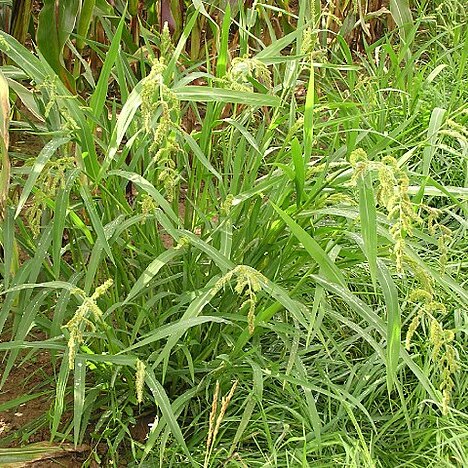Annual or perennial. Culms often coarse and robust. Leaf blades flat, linear or broadly linear; ligule absent (ciliate in some species outside China). Inflorescence composed of racemes along a central axis; racemes simple or compound, densely spiculate, spikelets paired in 4 rows, or congested on secondary racemelets. Spikelets narrowly elliptic to subrotund, plump, plano-convex, often hispidulous or spinulose, acute to awned; lower glume triangular, 1/3–1/2(–3/5) spikelet length, sheathing; upper glume and lower lemma equaling the spikelet or upper glume somewhat shorter in cultivated forms, prominently 5–7-veined, acute to rostrate or lower lemma extended into a stout awn; upper lemma coriaceous, smooth, shining, terminating in a short, laterally compressed, incurving beak; upper palea acute, apex briefly reflexed. x = 9.
Spikelets planoconvex, with one perfect terminal fl and one neuter (ours) or sometimes staminate floret below, sessile or nearly so, crowded in 4–several rows in thick racemes or spikes, these aggregated into a terminal panicle; first glume 3-veined, awnless or minutely awn-tipped, usually less than half as long as the second; second glume and sterile lemma prominently 5-veined, surpassing the fertile lemma, one or both often awned from the tip; sterile lemma with a well developed palea; fertile lemma with a firm, cartilaginous, rounded, smooth, shiny body narrowed to a ± differentiated tip, its palea of similar texture, with the margins (but not the tip) clasped by the lemma; ours annuals with compressed sheaths, no ligule, and soft, elongate lvs, these incised at the base. 40, mostly in warm reg.
Spikelets subsessile, solitary or in pairs in two rows on one side of a slender rachis, scabrous and sparsely to prominently hispid; first glume broad, triangular, acute, 3-nerved; second glume and sterile lemma nearly equal, 5-to 7-nerved, the lateral nerves approximate, mucronate, or the glume short-awned, the lemma long-awned, sometimes enclosing a palea and staminate flower; fruit plano-convex, elliptic, minutely crested, indurate, shining, minutely striate, the margins of the lemma not inrolled, the tip of the palea not enclosed.
Superior lemma crustaceous, terminating in a short, membranous, laterally compressed, incurved beak; superior palea acute, the apex briefly reflexed and slightly protruberant from lemma.
Inflorescence of racemes along a central axis, the spikelets paired or in short secondary racemelets, typically densely packed in 4 rows.
Spikelets narrowly elliptic to subrotund, flat on one side gibbous on the other, often hispidulous, the apex usually cuspidate or awned.
Glumes acute to acuminate, the inferior usually c. 1/3, the superior as long as spikelet.
Inferior lemma often stiffly awned.


